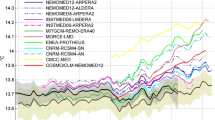We study model climatic temperature and salinity fields and the fields of currents in the 350–1000-m layer. The following specific features are revealed: Colder waters are observed in the regions with anticyclonic vorticity. At the same time, warmer waters are detected in the regions with cyclonic vorticity. This temperature effect can be explained by the elevation of temperature with depth below the main pycnocline. In the region of the Sevastopol anticyclone, at depths greater than 500 m, we observe a zone of cyclonic rotation of waters. Near the Caucasian coast, in the region of Gelendzhik, we reveal a narrow jet current existing at a depth of 350 m from March till July.
Similar content being viewed by others
References
G. K. Korotaev, S. G. Demyshev, and V. V. Knysh, “Three-dimensional climate of the Black Sea,” in: Black Sea Ecosystem Processes and Forecasting, METU, IMS, Erdemli (2000), pp. 1–10.
V. V. Knysh, S. G. Demyshev, G. K. Korotaev, and A. S. Sarkisyan, “Four-dimensional climate of seasonal Black Sea circulation,” Rus. J. Numer. Anal. Math. Model., 16, No. 5, 409–426 (2001).
S. G. Demyshev and G. K. Korotaev, Numerical energy-balanced model of baroclinic currents in the ocean with uneven bottom on grid C,” in: Numerical Models and the Results of Calibrating Calculations of Currents in the Atlantic Ocean [in Russian], Institute of Computational Mathematics, Russian Academy of Sciences, Moscow (1992), pp. 163–231.
S. G. Demyshev, V. A. Ivanov, N. V. Markova, et al., “Construction of the field of currents in the Black Sea on the basis of an eddy-resolving model with assimilation of the climatic temperature and salinity fields,” in: Ecological Safety of the Coastal and Shelf Zones and Complex Utilization of the Shelf Resources [in Russian], Marine Hydrophysical Institute, Ukrainian Academy of Sciences, Sevastopol (2007), pp. 215–226.
J. V. Staneva and E. V. Stanev, “Oceanic response to atmospheric forcing derived from different climatic data sets. Intercomparison study for the Black Sea,” Oceanologiya, 21, No. 3, 383–417 (1998).
V. L. Dorofeev and G. K. Korotaev, “Assimilation of the satellite altimetry data in the eddy-resolving model of circulation in the Black Sea,” Morsk. Gidrofiz. Zh., No. 1, 52–68 (2004).
Hydrometeorology and Hydrochemistry of Seas in the USSR. Vol. 4: Black Sea, Issue 1: Hydrometeorological Conditions [in Russian], Gidrometeoizdat, St.-Petersburg (1991), pp. 103–262.
R. C. Pacanowski and S. G. H. Philander, “Parametrization of vertical mixing in numerical models of tropical oceans,” J. Phys. Oceanogr., 11, No. 11, 1443–1451 (1981).
S. G. Demyshev, V. V. Knysh, and G. K. Korotaev, “Simulation of the seasonal variability of temperature conditions in the upper active layer of the Black Sea,” Izv. Ros. Akad. Nauk, Fiz. Atmosf. Okean., 40, No. 2, 259–270 (2004).
V. N. Belokopytov, Thermohaline and Hydroacoustic Structures of Waters in the Black Sea [in Russian], Author’s Abstract of the Doctoral Degree Thesis (Geography), Marine Hydrophysical Institute, Ukrainian Academy of Sciences, Sevastopol (2004).
S. G. Demyshev, V. V. Knysh, and G. K. Korotaev, “Results of the numerical analysis of adapted fields in the Black Sea based on the assimilation of data on climatic temperature and salinity in the model,” Izv. Ros. Akad. Nauk, Fiz. Atmosf. Okean., 42, No. 5, 604–617 (2006).
V. A. Ivanov, V. K. Kosnyrev, É. N. Mikhailova, et al., “Numerical simulation of upwellings on the northwest shelf and in the region of continental slope in the Black Sea,” in: Diagnostics of State of the Media of the Coastal and Shelf Zones in the Black Sea [in Russian], Marine Hydrophysical Institute, Ukrainian Academy of Sciences, Sevastopol (1996), pp. 17–30.
Author information
Authors and Affiliations
Additional information
Translated from Morskoi Gidrofizicheskii Zhurnal, No. 1, pp.3–15, January–February, 2009.
Rights and permissions
About this article
Cite this article
Demyshev, S.G., Ivanov, V.A. & Markova, N.V. Analysis of the Black-Sea climatic fields below the main pycnocline obtained on the basis of assimilation of the archival data on temperature and salinity in the numerical hydrodynamic model. Phys Oceanogr 19, 1–12 (2009). https://doi.org/10.1007/s11110-009-9034-x
Received:
Revised:
Published:
Issue Date:
DOI: https://doi.org/10.1007/s11110-009-9034-x



